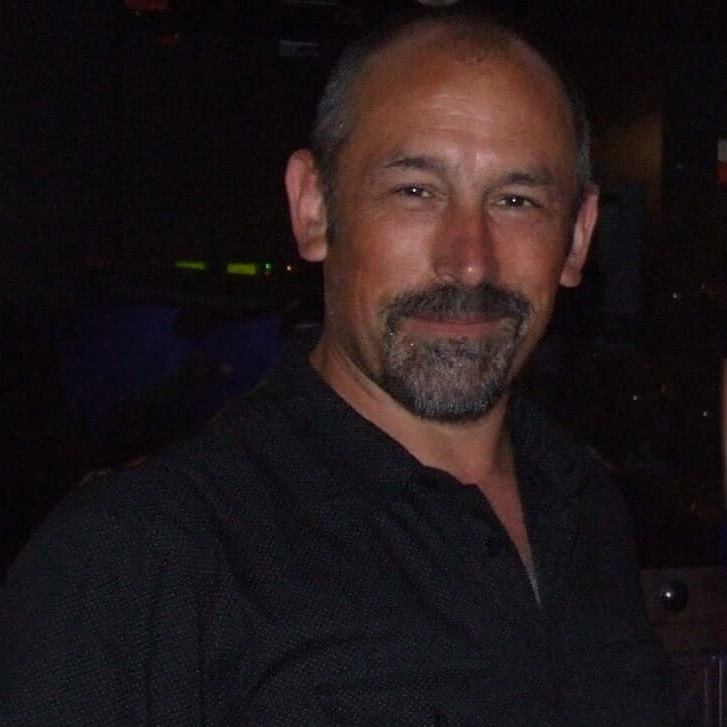Background
Murray Bruton is a lifelong Martial Arts practitioner who first stepped onto the mats (or more appropriately the cold hard stone floor) of a dojo as a Bruce Lee inspired 13 year old in 1973. With brief flirtations along the way in western boxing and White Crane Kung Fu, he settled into what he nowadays describes as the imaginary fighting art of Karate.
In line with his growing realisations, he dumped the imaginary for more realistic fighting disciplines in 2009 and, although his main discipline these days is Brazilian Jiu Jitsu (he is the proud owner of the Gracie Barra Academy in his home town of Gloucester) he also separately continues to pursue his study of the science of survival fighting as a personal student of the maverick fighting realist Steve Morris!
Murray Bruton
Helping people develop the physical skills and just as importantly, gain the knowledge and confidence to act in a pressure situation where the consequences of not getting it right first time can be catastrophic has been a theme for my whole life it seems.
In his working career, prior to 2010 he was as a freelance training provider of Corporate First Aid at Work, Conflict Management, Physical Intervention and Personal Safety courses. He then joined a large international NGO to pursue his volitional ambitions in the tougher sectors of First Aid Education, delivering targeted one-off interventions whilst working with deprived local communities, substance misusers, rehab centres, rough sleepers, victims of domestic violence, pupil referral units, ex-offenders and other marginalised and vulnerable groups.
From 2015-2019 he served as an advisor/analyst to the senior management team of the Education Directorate of this world leading NGO. A team that were instrumental in helping the worlds principal first aid/resuscitation organisations (IFRC,ILCOR et al) to define the evidence based process and best practice educational pedagogy through which First Aid skills and knowledge are taught globally today.
So, Murray’s lifetime immersion in Martial Arts training, both as a practitioner and as a coach, his years of experience as a First aid trainer and his role as a professional advisor with significant accumulated knowledge of the science, evidence and rationale that underpins both the best practice First Aid actions, and the best practice Educational methods by which they are conveyed to non professionals, is the unique triangulation that has led to the founding of GYMSAFEuk.
He left his NGO role in early 2019 to concentrate on the development of his Academy and, importantly, with the purpose of addressing what initially he had identified as a growing issue in the Brazilian Jiu Jitsu Community in the UK.
He says “I may have moved on from the charity sector now, but my humanitarian instincts remain undiminished by doing so! that said, helping people develop their physical skills, and importantly, have the confidence and willingness to execute them in a pressure situation, where the consequences of not getting it right first time can be catastrophic, has been a theme for my whole life it seems!
What I have learned through my career is that helping people get ready for what are known as serious “critical events” requires a unique type of preparation. Instant recognition of what’s happening, rapid evaluation of tactical options and the embodied physical skills to execute them under pressure requires preparation that is devoted to developing these attributes in the trainee, which in turn, requires inclusion of every element of the real event you are actually training for in the first place!
Sound obvious? it is… until that is, you realise that by far the best method for developing physical skills is known as “on the job training” I.e where you learn to do, refine and continuously repeat your practice under supervision, eventually developing your expertise, all whilst doing the job and getting better at it under the pressures that come with it.
Clearly, because of the risks and consequences involved, learning on the job is not an option for critical events training, and so people turn to specialist training providers to help them prepare (martial arts/self defence instructors, First Aid Instructors, Sports coaches etc).
These providers, some of whom may well have developed their own expertise “on the job” must wrestle with the conundrum of how to teach people to do what they themselves can do, yet do so without them doing the very training they did. The answer to this conundrum for most is to construct either imaginary, simulated, or theoretical training!, arrived at simply by the priority to remove the risk of error and consequence of failure from the training experience for training safety reasons. The trouble is, by removing these essential elements, the value of the training experience is significantly diminished if not completely negated.
It is impossible in such “training” to develop the type of confidence known as self efficacy that can only come from the experience of proven skills tried, tested and refined under real world pressure!
What it will develop however, and perhaps this is the worst of all scenario’s, is the inflated false confidence that people walk around with because they’ve “done the training” and which time and again has been proven to crumble away at the precise moment of “real world” need!
Put simply
“If you can’t do your training for the job on the job, then you must bring the job into your training”
He adds:
The thing is, there are Governing bodies of Combat Sport(s) & Martial Arts in the UK that rightly and responsibly require instructors and coaches to be ”First Aid trained”! The rationale behind this requirement is to ensure that injuries or illnesses that might occur during training or practice can be recognised and treated appropriately, in order to reduce the harm experienced by the casualty on the mat.
Laudable that this is, there is an issue that is cause for some concern; namely, full time academies are a place of work and so school owners need to comply with their legal obligations under the Health and Safety (First Aid) Regulations 1981…however, that same Health and Safety law (and the First Aid courses designed to meet it) specifically do not cover safety matters arising out of a sport or activity itself!
So we currently have a conflicting situation, vis-à-vis it is recognised that instructors/coaches should be First Aid trained to meet the needs of practitioners of the sport, but the legal obligations of full time academy owners to comply with H&S law takes precedence, meaning that they and/or their staff are in fact being inadequately trained to meet the needs of their students because they are attending courses designed to meet the needs of employees (and specifically not the practitioners of their sport).
There will no doubt be some First Aid training providers that will argue that the HSE current workplace curriculums (FAW/EFAW certified courses) sufficiently cover the sporting risks “after all a broken bone is a broken bone etc” but even the HSE recognise that this might not be the case. They say:
“Competitors/players taking part in competitions and/or training are generally subject to non-statutory rules set down by sports National Governing Bodies (NBGs). These rules will include topics like supervision (coaching staff to player ratios) and training, plus ‘in play’ emergency procedures and medical provision. Some of these rules and procedures may go beyond the requirements of workplace health and safety legislation”
I would certainly argue that without a deep understanding of the mechanics of injury involved in the practice of the sport, it’s a pretty broad assumption to make, and besides, when you look at the statutory curriculum of either of the workplace qualifications, there is clearly a lot of important stuff missing!
There is one more additional consideration, highlighted in the International First Aid and Resuscitation Guidelines 2016 published by the International Federation of Red Cross & Crescent Societies (For National Society First Aid programme managers, scientific advisory groups, First Aid instructors and first responders).
This report used an evidence based approach to formulate guidelines on the use of those educational methods proven as the best way for learners to learn and retain how to respond in a first aid situation. This inclusion of a chapter on appropriate Education methodology for the first time, clearly acknowledges the importance of an effective education approach and the guidelines are very clear about creating relevant contexts, learner engagement, learning modalities, restriction of content etc in order to do so. It also re-enforces that Education course designers use these evidence-based guidelines, to strengthen the first aid knowledge, skills, and behaviours of their learners in order to best serve the needs of an ill or injured person.
Murray, along with former colleagues has designed, in line with his experience and qualifications, a programme of First Aid Education for BJJ (and additional programmes for other Combat Sports and Martial Arts) commensurate with the best practice educational pedagogy’s for non health care professionals that is based upon his experience of the risks involved in their practice; whilst at the same time covering the legal obligations of gym owners under Health & Safety law
Get in touch
If you are a combat sports gym owner (BJJ/MMA/Wrestling/Judo/Sambo/Muay Thai etc) looking to cover your legal obligations in terms of making adequate First Aid provision for your employees as well as your students, ensure you have bullet proof Safeguarding measures in place to protect your young athletes or you are determined to foster a training environment that genuinely promotes Equality and Diversity in your chosen sport or Martial Art, then please feel free to get in touch!
Get in touch ▸
“When it comes to Student Safety we simply will not compromise”

